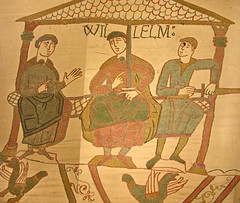By Stuart Frost
The 14 October 1066 is arguably the most famous date in English history, even if most people remember the year rather than the day and month. The Battle of Hastings didn’t actually take place at Hastings. If you get off the train there looking for the site where Harold Godwinson died you’ll be disappointed. The nearest train station is at Battle. From there it is a few hundred meters to the ruins of Battle Abbey, founded by William the Conqueror on the site of his victory. Each year, on the weekend nearest to the actual date, the Battle of Hastings takes place at Battle all over again.
The Bayeux Tapestry, actually an embroidery, gives a very good impression of what the battle must have been like. Many of the scenes capture the violence and chaos of the fighting remarkably vividly. The original tapestry is in Bayeux, but Reading Museum is home to a life-size copy that was embroidered in the 19th century. Not all of the ladies who made this copy travelled to Bayeux to study the original. They used an actual-size hand-coloured photograph that was produced in the 1870s. The V&A holds this photographic copy in its collections. In fact the V&A has two photographic copies, both of which were originally on display at the Museum and which once merited their own guide book. Neither of these photographs is on public display at the moment, but we are hoping to include a section from one of them in a Discovery Area in the new Medieval and Renaissance galleries.
The Reading version of the tapestry isn’t an exact copy. For example, there is a naked male figure in the lower border of the original. One of those embroiderer’s working on Britain’s ‘very own copy’ decided to give this little chap a pair of shorts to cover his obvious exuberance. There are other examples of 19th century prudery in relation to medieval and Renaissance art. Fortunately the V&A’s plaster cast copy of Michelangelo’s David was provided with a fig-leaf rather than a pair of woollen shorts.
Find out more about the Medieval and Renaissance Galleries Project.
Explore Reading Museum’s tapestry online.


Why is it that the public have lost interest in the Bayeux Tapestry? It is really interesting to see that even copies of the tapestry were once valued enough to have their own guide book at the museum. With new media technology developing so rapidly it would be nice to think that some interesting and innovative methods of bringing the tapestry story to life again could be developed.
What I love about the tapestry is that it not only relates the exciting events of the Norman invasion, but it includes many incidental details which tell us a great deal about everyday life in the period such as what people wore and what they ate.
I agree that is the details that make the tapestry such a fascinating object. If it hadn’t survived the whole way we visualise, or imagine, the Battle of Hastings would be radically different.
I remember reading an article in a paper a few years ago where someone had made another copy of the tapestry so perhaps it still does inspire people after all? Unfortunately I can’t remember what this copy was made of, who made it, or where it is now. Perhaps someone out there can help me find it?
It is most definitely not forgotten about, it is the one thing I remember most from Year 7 history at school (AGE 11). We spent a whole year on the topic of medieval times and events and when this blog was mentioned in our A Level art class, everyone knew what the Bayeux Tapestry was…we also found a book on the topic in our art room within 5 minutes of mentioning it.
We have just had a revision of our history lessons thanks to this.
I have happy memories of many hours spent recreating the Bayeux Tapestry (chain-mail stitch anyone) at primary school. We were only 8 years old but we had a good go at it and it’s stuck in my memory forever. I’ve since visited both Battle and the Tapestry as well and each time I think of chain mail stitch.
Has anyone read recently about the lady who has recreated the Bayeux Tapestry? Her name was Annette Banks and she had Cushing’s Syndrome. She recreated the tapestry as a tribute to her father who suggested the idea but sadly died before she finished it. This link has the full story.
I remember spending a the whole of Year Seven learning about it. My history teacher was very passionate about it.
Hello everyone,
My name is Mark Banks and my mother is the person who done this work (recreation of the tapestry) and trust me when I say “When you see it, the feeling is over whelming.” Anyway, just to let the website master and every one that my mothers work is now online at http://www.annettebanks.co.uk.
Thanks again as my mother love reading